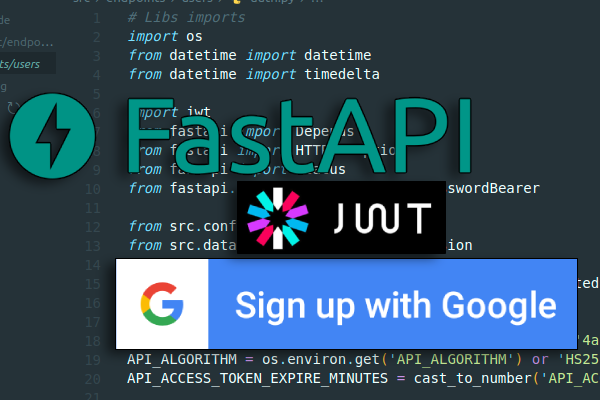This guide is a follow up to Use Google Login (OAuth) with FastAPI - Python, in the previous guide We allowed the user to login using its Google Credentials via OAuth in our FastAPI project.
In this guide we are going to create a JWT when the user is logged in and use the JWT Bearer token authentication for the private endpoints.
The FastAPI application created in the previous guide uses a Starlette middleware to read the session cookies, we are going to limit the use of this middleware to just the login y auth endpoints. The rest of the application is going to run without middlewares.
Requirements
This guide assumes you already have installed in your system python3.8 (or newer).
All the steps to create the Google Credentials and the login and auth endpoint are defined in Use Google Login (OAuth) with FastAPI - Python.
Support for endpoints with different middlewares
With FastAPI we can not set just an endpoint to use a middleware, it applies to all the routes. There is a way to resolve this, we can create two sub-apps and then mount both of them in our main app.
We are going to start developing on top of the last guide.
git clone -b guide-1 https://github.com/hanchon-live/tutorial-fastapi-oauth.git
cd tutorial-fastapi-oauth
# Create the virtualenv, activate it, and install the requirements
python3 -m venv .venv
source .venv/bin/activate
pip install -r requirements.txt
Shell
Let’s create two simple apps and mount them in our main file:
Create the empty file: apps/__init__.py
Create the file: apps/auth.py
import os
from fastapi import FastAPI
from starlette.middleware.sessions import SessionMiddleware
from starlette.responses import JSONResponse
# Create the auth app
auth_app = FastAPI()
# Set up the middleware to read the request session
SECRET_KEY = os.environ.get('SECRET_KEY') or None
if SECRET_KEY is None:
raise 'Missing SECRET_KEY'
auth_app.add_middleware(SessionMiddleware, secret_key=SECRET_KEY)
@auth_app.get('/')
def test():
return JSONResponse({'message': 'auth_app'})
Python
apps/auth.py
Create the file: apps/api.py
from fastapi import FastAPI
api_app = FastAPI()
@api_app.get('/')
def test():
return {'message': 'api_app'}
Python
apps/api.py
Create the file /main.py
import uvicorn
from fastapi import FastAPI
from apps.api import api_app
from apps.auth import auth_app
app = FastAPI()
app.mount('/auth', auth_app)
app.mount('/api', api_app)
@app.get('/')
async def root():
return {'message': 'main_app'}
if __name__ == '__main__':
uvicorn.run(app, port=7000)
Python
./main.py
We can test it by running the main.py file. Make sure to set the SECRET_KEY variable on your environment or create a script to run the file.
Example run.sh
source .venv/bin/activate
# export GOOGLE_CLIENT_ID=...
# export GOOGLE_CLIENT_SECRET=...
export SECRET_KEY=...
python3 main.py
Shell
Test the endpoints (using a terminal or a browser), / is our main app, /auth uses the Starlette middleware and /api has no middleware.
$ curl 127.0.0.1:7000
{"message":"alive"}
$ curl 127.0.0.1:7000/api/
{"message":"api_app"}
$ curl 127.0.0.1:7000/auth/
{"message":"auth_app"}
Shell
Move the auth code to the auth app
Now that we have a sub-application for everything that is google login related, we are going to move the code in the run.py file, created in the previous guide, to the app/auth.py file.
From that code we need the /login and the /auth endpoints. Let’s rename /auth to /validate_token** so it’s not confusing with our sub-application base route.
Modify your Google Cloud domains:
We need to modify the authorised domains because now we are going to redirect to a new endpoint.
Access to the Google Cloud Console with your Google account: Google Cloud
Go to Credentials -> OAuth client ID -> Click on edit your application
Change http://127.0.0.1:7000/auth to http://127.0.0.1:7000/token
This /token url it’s a frontend route. We are going to redirect the user after entering the google credentials to the frontend, and then pass it to the server to validate the response (using javascript).
The frontend can be hosted on any domain, we just need to change the url in this section and make the host available on a CORSMiddleware on the FastAPI app:
from fastapi.middleware.cors import CORSMiddleware
ALLOWED_HOSTS = ["*"]
app.add_middleware(
CORSMiddleware,
allow_origins=ALLOWED_HOSTS,
allow_credentials=True,
allow_methods=["*"],
allow_headers=["*"],
)
Python
Move the run.py code to apps/auth.py
We are going to move the auth route code to the newly created validateToken route, this endpoint will validate the token sent by google and create and send a JWT Token to the frontend. We are going to set the redirect_uri to our frontend, so it can have the data to later request a JWT token to the server.
So the flow will be:
Enter the auth_app/login endpoint.
It will take us to the Google Credentials pages.
It will redirect us to our frontend.
The frontend will request the server to generate a valid JWT after validating the google credentials response.
File: apps/auth.py
import os
from authlib.integrations.starlette_client import OAuth
from authlib.integrations.starlette_client import OAuthError
from fastapi import FastAPI
from fastapi import HTTPException
from fastapi import Request
from fastapi import status
from starlette.config import Config
from starlette.middleware.sessions import SessionMiddleware
from starlette.responses import JSONResponse
# Create the auth app
auth_app = FastAPI()
# OAuth settings
GOOGLE_CLIENT_ID = os.environ.get('GOOGLE_CLIENT_ID') or None
GOOGLE_CLIENT_SECRET = os.environ.get('GOOGLE_CLIENT_SECRET') or None
if GOOGLE_CLIENT_ID is None or GOOGLE_CLIENT_SECRET is None:
raise BaseException('Missing env variables')
# Set up OAuth
config_data = {'GOOGLE_CLIENT_ID': GOOGLE_CLIENT_ID, 'GOOGLE_CLIENT_SECRET': GOOGLE_CLIENT_SECRET}
starlette_config = Config(environ=config_data)
oauth = OAuth(starlette_config)
oauth.register(
name='google',
server_metadata_url='https://accounts.google.com/.well-known/openid-configuration',
client_kwargs={'scope': 'openid email profile'},
)
# Set up the middleware to read the request session
SECRET_KEY = os.environ.get('SECRET_KEY') or None
if SECRET_KEY is None:
raise 'Missing SECRET_KEY'
auth_app.add_middleware(SessionMiddleware, secret_key=SECRET_KEY)
# Frontend URL:
FRONTEND_URL = os.environ.get('FRONTEND_URL') or 'http://127.0.0.1:7000/token'
@auth_app.route('/login')
async def login(request: Request):
redirect_uri = FRONTEND_URL # This creates the url for our /auth endpoint
return await oauth.google.authorize_redirect(request, redirect_uri)
@auth_app.route('/token')
async def auth(request: Request):
try:
access_token = await oauth.google.authorize_access_token(request)
except OAuthError:
raise HTTPException(
status_code=status.HTTP_401_UNAUTHORIZED,
detail='Could not validate credentials',
headers={'WWW-Authenticate': 'Bearer'},
)
user_data = await oauth.google.parse_id_token(request, access_token)
# TODO: validate email in our database and generate JWT token
jwt = f'valid-jwt-token-for-{user_data["email"]}'
# TODO: return the JWT token to the user so it can make requests to our /api endpoint
return JSONResponse({'result': True, 'access_token': jwt})
Python
apps/auth.py
Create a frontend to test the authentication
We are going to write the frontend in our main app.
The route / will only have a Log In button, to call the /auth/login endpoint. The route /token will have a button to request the server to generate a JWT token with the google response. (This process ideally will be automatically called, but let’s make a button to see how it works).
File: main.py
import uvicorn
from fastapi import FastAPI
from fastapi import Request
from fastapi.responses import HTMLResponse
from apps.api import api_app
from apps.auth import auth_app
app = FastAPI()
app.mount('/auth', auth_app)
app.mount('/api', api_app)
@app.get('/')
async def root():
return HTMLResponse('<body><a href="/auth/login">Log In</a></body>')
@app.get('/token')
async def token(request: Request):
return HTMLResponse('''
<script>
function send(){
var req = new XMLHttpRequest();
req.onreadystatechange = function() {
if (req.readyState === 4) {
console.log(req.response);
if (req.response["result"] === true) {
window.localStorage.setItem('jwt', req.response["access_token"]);
}
}
}
req.withCredentials = true;
req.responseType = 'json';
req.open("get", "/auth/token?"+window.location.search.substr(1), true);
req.send("");
}
</script>
<button onClick="send()">Get FastAPI JWT Token</button>
''')
if __name__ == '__main__':
uvicorn.run(app, port=7000)
Python
main.py
After running the application we can check that everything is working as intended, to check if it’s really validating the token, we can just change a letter on your browser’s url bar when the /token page is shown and then press generate JWT Token It will return an error 401.
JWT
We are going the create a jwt.py file to code all the functions related to the token.
Install PyJWT lib:
We are going to add to the virtualenv the pyjwt lib, so we can safely create and decode tokens.
# With the virtualenv already activated
pip install pyjwt
Shell
Create and decode tokens:
We are going to need a secret key for our tokens, we can create one using the same method for the secret key used in the Starlette’s Middleware configuration step in the previous guide (Create Secret key with python).
To avoid creating a database just for this example, we are going to use a dictionary that only has one registered user.
create_Token will be the function that encodes the token and get_current_user_emailwill receive a token and returns us the email in case the token is valid.
Let’s create the file apps/jwt.py:
import os
from datetime import datetime
from datetime import timedelta
import jwt
from fastapi import Depends
from fastapi import HTTPException
from fastapi import status
from fastapi.security import OAuth2PasswordBearer
# Create a fake db:
FAKE_DB = {'guillermo.paoletti@gmail.com': {'name': 'Guillermo Paoletti'}}
# Helper to read numbers using var envs
def cast_to_number(id):
temp = os.environ.get(id)
if temp is not None:
try:
return float(temp)
except ValueError:
return None
return None
# Configuration
API_SECRET_KEY = os.environ.get('API_SECRET_KEY') or None
if API_SECRET_KEY is None:
raise BaseException('Missing API_SECRET_KEY env var.')
API_ALGORITHM = os.environ.get('API_ALGORITHM') or 'HS256'
API_ACCESS_TOKEN_EXPIRE_MINUTES = cast_to_number('API_ACCESS_TOKEN_EXPIRE_MINUTES') or 15
# Token url (We should later create a token url that accepts just a user and a password to use it with Swagger)
oauth2_scheme = OAuth2PasswordBearer(tokenUrl='/auth/token')
# Error
CREDENTIALS_EXCEPTION = HTTPException(
status_code=status.HTTP_401_UNAUTHORIZED,
detail='Could not validate credentials',
headers={'WWW-Authenticate': 'Bearer'},
)
# Create token internal function
def create_access_token(*, data: dict, expires_delta: timedelta = None):
to_encode = data.copy()
if expires_delta:
expire = datetime.utcnow() + expires_delta
else:
expire = datetime.utcnow() + timedelta(minutes=15)
to_encode.update({'exp': expire})
encoded_jwt = jwt.encode(to_encode, API_SECRET_KEY, algorithm=API_ALGORITHM)
return encoded_jwt
# Create token for an email
def create_token(email):
access_token_expires = timedelta(minutes=API_ACCESS_TOKEN_EXPIRE_MINUTES)
access_token = create_access_token(data={'sub': email}, expires_delta=access_token_expires)
return access_token
def valid_email_from_db(email):
return email in FAKE_DB
async def get_current_user_email(token: str = Depends(oauth2_scheme)):
try:
payload = jwt.decode(token, API_SECRET_KEY, algorithms=[API_ALGORITHM])
email: str = payload.get('sub')
if email is None:
raise CREDENTIALS_EXCEPTION
except jwt.PyJWTError:
raise CREDENTIALS_EXCEPTION
if valid_email_from_db(email):
return email
raise CREDENTIALS_EXCEPTION
Python
apps/jwt.py
Make sure you add your API_SECRET_KEY to your environment so your application can run without errors.
Return the JWT on auth/token endpoint:
Let’s import the necessaries functions and the exception to rewrite the /token route.
Add to the file apps/auth.py:
from apps.jwt import create_token
from apps.jwt import valid_email_from_db
from apps.jwt import CREDENTIALS_EXCEPTION
Python
And let’s replace the /token route in apps/auth.py:
@auth_app.route('/token')
async def auth(request: Request):
try:
access_token = await oauth.google.authorize_access_token(request)
except OAuthError:
raise CREDENTIALS_EXCEPTION
user_data = await oauth.google.parse_id_token(request, access_token)
if valid_email_from_db(user_data['email']):
return JSONResponse({'result': True, 'access_token': create_token(user_data['email'])})
raise CREDENTIALS_EXCEPTION
Python
apps/auth.py
If we test the application, the Get FastAPI JWT Token button will print on the browser console something similar to this:
{"result":true,"access_token":"eyJ0eXAiOiJKV1QiLCJhbGciOiJIUzI1NiJ9.eyJzdWIiOiJndWlsbGVybW8ucGFvbGV0dGlAZ21haWwuY29tIiwiZXhwIjoxNjE4ODczMjgyfQ.9dbl4ylFp2BWLNAVuOwixm0IrV2lr3t7xl2YKOHgC90"}
Shell
Make the api endpoints protected:
Let’s import the JWT function that we need to the file apps/api.py:
from apps.jwt import get_current_user_email
Python
apps/api.py
Let’s create two routes, one that requires the JWT Token and another that doesn’t need it.
from fastapi import Depends
@api_app.get('/')
def test():
return {'message': 'unprotected api_app endpoint'}
@api_app.get('/protected')
def test2(current_email: str = Depends(get_current_user_email)):
return {'message': 'protected api_app endpoint'}
Python
apps/api.py
Test the new routes:
Using the terminal we can check that they are working as intended:
$ curl 127.0.0.1:7000/api/
{"message":"unprotected api_app endpoint"}
$ curl 127.0.0.1:7000/api/protected
{"detail":"Not authenticated"}
Shell
Let’s call the protected endpoint using the JWT that we have stored in the localstore in our frontend. Update the main.py file to add a 3 new buttons to the route /tokenroute to test the functionality:
NOTE: I’m going to use javascript’s fetch to make the request simpler. Add this lines inside the HTMLResponse of the /token route in the main.py file:
<button onClick='fetch("http://127.0.0.1:7000/api/").then(
(r)=>r.json()).then((msg)=>{console.log(msg)});'>
Call Unprotected API
</button>
<button onClick='fetch("http://127.0.0.1:7000/api/protected").then(
(r)=>r.json()).then((msg)=>{console.log(msg)});'>
Call Protected API without JWT
</button>
<button onClick='fetch("http://127.0.0.1:7000/api/protected",{
headers:{
"Authorization": "Bearer " + window.localStorage.getItem("jwt")
},
}).then((r)=>r.json()).then((msg)=>{console.log(msg)});'>
Call Protected API wit JWT
</button>
Markup
./main.py
We can check that everything is working fine looking at the browser console:
# After generating the JWT token
{result: true, access_token: "eyJ0eXAiOiJKV1QiLCJhbGciOiJIUzI1NiJ9.eyJzdWIiOiJnd…zM2fQ.oTOHkvqvIYfAUwAxyg6w7z5IGAMjC2jP-kAoajHF7_4"}
# After calling /api/
{message: "unprotected api_app endpoint"}
# After calling /api/protected without JWT
GET http://127.0.0.1:7000/api/protected 401 (Unauthorized)
{detail: "Not authenticated"}
# After calling /api/protected with JWT
{message: "protected api_app endpoint"}
Shell
browser console
Link to the code
This app is uploaded to github, you can view the repository using this link, this tutorial is the branch guide-2
Related Guides
The part 1 of this tutorial explains how to create a Google Application, and how to integrate the Google OAuth with our FastAPI project.
The part 3 of this tutorial modifies the Tokens to improve its functionality and usability.

